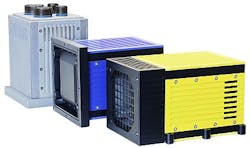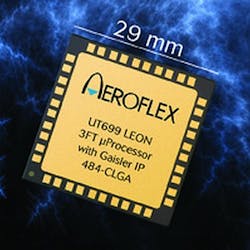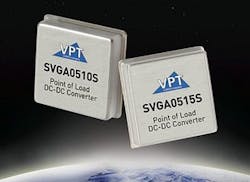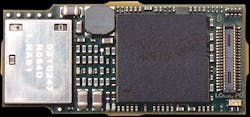Small-form-factor embedded computing shrinks processing for unmanned vehicles and other tiny applications
SPECIAL REPORT, 30 July 2012. There was a time not many years ago when 3U-size processor boards were among the smallest embedded computers imaginable. This form factor, 100 by 160 millimeters, or about the size of a paperback novel, opened a multitude of new applications for embedded computing, such as avionics for large unmanned vehicles, electronic subsystems for armored combat vehicles (vetronics), and portable electronics for soldiers on the battlefield. In that era, 6U computer boards were the standard, and 3U circuit cards were amazingly small.
Today, however, those paperback-book-sized embedded computing modules are starting to look large and clunky compared to the newest generations of small-form-factor embedded computing modules. Engineers are shrinking today's computer boards to the sizes of smartphones, credit cards, business cards, sticks of gum, and even postage stamps, which is encouraging systems designers to rethink their definitions of small-form-factor embedded computing.
Computer boards the sizes of credit cards can be embedded in computer monitors to transform them into advanced stand-alone computers. Business card-size embedded boards can provide image processing for some of the smallest unmanned aerial vehicles (UAVs) available, and postage stamp-sized boards can provide unobtrusive computing in handheld radios, weapon-mounted cameras, and other soldier-worn equipment.
Insatiable demand for small-for-factor embedded computing is driving vendors in several different directions. Many are gravitating to well-known form factors that either are industry standards, or are near-industry standards supported by industry consortia. Others are trying to formulate internationally recognized industry standards, and to build the necessary infrastructure and market ecosystems. Yet others are responding directly to customer demands and are devising custom small-form-factor designs that are application-specific.
Need for small form factors
Demand for small-form-factor embedded computing can be seen all around us. Almost everything electronic -- from sensors, to displays, to printers -- not only has to be small, but also has to be "smart," or contain some sort of onboard computing.
The smaller a device gets, the more size, weight, power, and cost (SWaP-C) becomes a crucial consideration in its design. SWaP-C is a central concern in a growing number of applications, ranging from computer gaming, home theater, and digital signage, to cell phones, handheld devices, and unmanned vehicles.
"Applications tend to drive technology," says Steve Edwards, chief technology officer for COTS Solutions at Curtiss-Wright Controls Defense Solutions in Ashburn, Va. "We are seeing applications that are really SWaP-C constrained, like some of the small to mid-size UAVs. Designers have to fit everything into tens of pounds of payload, and you can't do that with 3U and 6U circuit cards."
Other kinds of unmanned vehicles, robotics, and soldier-wearable systems also are major applications drivers for small-form-factor embedded computing. "As small form factor gets smaller, so does the power that goes with the module," says Jack London, product manager for computer-on-module (COM) products at Kontron in Poway, Calif.
Small form factor embedded computing particularly is applicable to wearable PCs, robotics for surveillance and security, and in-vehicle PCs for military vehicles, London says. In commercial avionics applications he also points to in-flight entertainment systems and seat-back entertainment systems in commercial airliners as candidates for this kind of technology.
"Avionics have a lot more computing requirements today that need multiple processors," says Jeff porter, principal engineer at Extreme Engineering Solutions Inc. (X-ES) in Middleton, Wis. He cites "avionics where you have requirements for just a single processor for sensor processing where you don't need a large rack of processors" as another small-form-factor applications driver.
Standard products
Embedded computing experts are applying a wide variety of industry standards to small-form-factor computing for aerospace and defense applications, including COM Express, PC/104, Qseven, Express Mezzanine Card (XMC), and others.
"There are a lot of competing standards out there now: Com Express, PC/104, Qseven, and a lot of custom stuff," says Curtiss-Wright's Edwards. "There is not a drive toward any one standard at the moment. People are living with their limitations and hoping for something better in the future."
The small-form-factor standards now in use sometimes have drawbacks, Edwards says. Shortcomings usually revolve around how rugged these standards are and how well they can stand up to the kinds of shock, vibration, humidity, and temperature extremes common in aerospace and defense electronic systems.
Edwards uses the example of PC/104 and PC/104-plus embedded computers, which often can be appropriate for digital signage, outdoor kiosks, and other industrial-grade applications. These standards, however, are "considered to be not as rugged as what we're used to" in military and aerospace applications, he says.
Express Mezzanine Card (XMC)
Engineers at BittWare Inc., a high-performance embedded computing vendor in Concord, N.H., are designing a small-form-factor computer board based on the Express Mezzanine Card (XMC) form factor standard of the VITA Open Standards, Open Markets trade association in Scottsdale, Ariz.
The upcoming product is called ACXM -- short for Anemone-Cyclone XMC -- and will have the Altera Hard Processor System with the Altera Cyclone 5 FX field-programmable gate array (FPGA) with embedded ARM Cortex-A9 processor, A-D and D-A converters, with the BittWare Anemone floating-point FPGA coprocessor.
The target applications for the ACXM small-form-factor embedded computer will be software-defined radio, as well as man-portable and vehicular electronic warfare, signals intelligence, and counter-improvised explosive device (IED) systems, explains Jeff Milrod, BittWare's president and CEO.
"It's a regular, full-performance FPGA that has a variety of configurations up to 300,000 logic elements," Milrod says. The device will enable systems designers to do standard FPGA processing, to use the ARM processor to run standard control software, and the Anemone floating-point co-processor to the FPGA. "Anemone is a co-processing engine that runs standard c development tools to implement high-performance algorithms in floating point."
Although BittWare engineers could have designed the ACXM processor as a full-custom product, they chose to use the XMC form factor to appeal to systems designers who rely on standard products. "We wanted to do it on something standard, so we are using the XMC format," Milrod says. It is just because of the lack of anything else better to use."
COM Express
One standard becoming popular for small-form-factor embedded computing is COM Express, which refers to computer-on-module computing that follows the PCI Express standard of the PCI Industrial Computer Manufacturers Group (PICMG) in Wakefield, Mass.
Engineers at X-ES base many of the company's small-form-factor embedded computing offerings on COM Express because of industry familiarity with the standard, its small size, and flexibility in design.
"COM Express has a number of different sizes," ranging roughly from the size of a CD case to a business card," explains X-ES's Porter. "We found inherent inefficiencies in 3U and with mezzanine card form factors," he says. COM Express can be placed directly on a cold plate for cooling, and from a real-estate standpoint you don't have a lot of excess overhead."
COM Express does have its down sides for aerospace and defense applications, however, Porter admits. "From a ruggedization standpoint, it doesn't support expectations for rugged avionics," he says. The notion of built-in test (BIT) also is a weakness of COM Express. "BIT isn't something most of the COM Express vendors understand. We can add that as our customers need it."
Embedded computing experts at Kontron have been active in the formation of the COM Express standard, as well as the Embedded Technology eXtended (ETX) standard, and are supporting the Pico-ITX is a PC motherboard form factor for small-form-factor computing.
Still, the COM Express 2.0 standard today is among the most relevant standards for those designing small-form-factor systems, Kontron's London says. "We see COM Express as relevant for the next several years because it provides industry-standard form factors that integrators can count on consistently."
For its small-form-factor offerings Kontron is proposing a new industry standard called ULP COMM, which is short for Ultra Low Power Computer on Module. "It's literally the size of a credit card, with a gold connector to support ARM processor technology and future X86-based platforms," London says.
VITA standards initiatives
It is the issue of being rugged enough for aerospace and defense applications that is driving the VITA standards group to work on formulating three separate small-form-factor embedded computing standards. The companies spearheading these three efforts are PCI Systems Inc. in Sunnyvale, Calif.; Themis Computer in Fremont, Calif.; and Curtiss-Wright Controls Defense Solutions with help from partner Mercury Computer Systems in Chelmsford, Mass.
The first of these standards in progress is called VITA 73, which focuses on PCI Systems. "I think a small-form-factor standard like VITA 73 must be totally different from what's out there, but that has the processing power to compete with 3U VPX," says Claus Gross, president of PCI Systems.
"We want to build on a small form factor like a COM Express, but to make a system that fits into a small box with backplane, and also that is available as a mezzanine card," Gross says, adding that the size of VITA 73 embedded computing modules will be roughly the size of a 2.5 hard drive.
The idea behind VITA 73 is to create modules that are smaller overall, but that actually have more space for components on board, than 3U VPX, Gross says. The VITA 73-double design achieves just this, Gross says. It has two connectors and innovative cooling in a design that can stand alone in a system design or in tandem with other cards in a backplane databus architecture.
As part of the VITA 73 effort, PCI Systems engineers are working on small connectors with optical links to join VITA 73-based boxes over optical fiber running at speeds as fast as 100-gigabit Ethernet, he says.
The company also is working on VITA 73 backplane architectures that accommodate from three to 14 computer boards. The enclosures for these systems will be able to dissipate more than 240 Watts of heat, "which is a lot for a small-form-factor system, or even for a 3U system," Gross says.
The next VITA small-form-factor standard in the works is VITA 74, and its primary architect is Themis Computer. Of the three VITA small-form-factor standards, VITA 74 is perhaps the farthest along, and Themis engineers are working with other embedded computing and peripheral companies to build an industry infrastructure and ecosystem to support it, says Bill Ripley, director of business development at Themis for tactical systems.
Themis designers are basing VITA 74 on the Nano ETX Express form factor, which came out of COM Express standard and is about the size of a credit card, Ripley says. "We built a CPU modules where we could build a carrier that would accept a Nano ETX single board computer mezzanine," he says.
The VITA 73 single-board computer can fit in a one-module enclosure that Themis calls the Nano Pack, which is being designed into smart displays and similar applications, as well as in several other formats. Themis has demonstrated a cube-sized package with four VITA 74 boards, and is working on a 10-slot VITA 74 chassis, Ripley says.
Themis is working together with MILCOTS LLC of Monsey, N.Y., to develop a two-slot display that combines computer and graphics processing to create a small digital video recorder. Themis also is working with VectorNav Technologies LLC in Richardson, Texas, to build a VITA 74 system that combines computer processing with GPS and inertial navigation capability.
The third VITA small-form-factor standard in development, VITA 75, and is the primary responsibility of Curtiss-Wright and partner Mercury Computer. The VITA 75 takes a fundamentally different approach from VITA 73 and VITA 74, in that Curtiss-Wright and Mercury are concentrating on a standard enclosure, connectors, and I/O, rather on separate computer modules.
"We're focused at the system level, and on defining box sizes and connector pinouts," says Curtis Reichenfeld, chief technology officer of the system solutions group at Curtiss-Wright Controls Defense Solutions. "We're looking at a PC/104-type of stackable configuration, but with more speed and more modern data buses."
"Our thinking is a small, replaceable, box-level form factor is what our customers are looking for," says Tom Roberts, solutions marketing manager at Mercury Computer. "The connectors are all standardized, so later designers can pull out the box and replace it with a new box. It should fit right in."
Custom approaches
Sometimes standard form factors -- small though they may be -- are insufficient for the most demanding applications. That is where tiny custom embedded computers like the System on Module (SOM) by Logic PD Inc. in Minneapolis come in. "We call it the Torpedo form factor," says Mark Benson, director of software strategy at Logic PD.
The Torpedo form factor embedded computer uses the Texas Instruments DM 3730 ARM processor, which uses a proprietary process to package memory and processor on top of one another. The finished package is about the size of a dime.
Other custom form factors are coming to bear on the smallest system designs, including a computer module about the size of a gun stick from Gumstix Inc. in Portola Valley, Calif.
Company information
AAEON Electronics Inc.
Hazlet, N.J.
www.aaeon.com
ACCES I/O Products Inc.
San Diego
http://accesio.com
ADL Embedded Solutions Inc.
San Diego
www.adl-usa.com
ADLINK Technology Inc.
Taipei, Taiwan
www.adlinktech.com
Advantech Corp. Industrial Automation Group
Cincinnati
www.advantech.com
American Portwell Technology Inc.
Fremont, Calif.
www.portwell.com
BittWare Inc.
Concord, N.H.
www.bittware.com
CONTEC Co. Ltd.
Osaka, Japan
www.contec.com
Curtiss-Wright Controls Defense Solutions
Ashburn, Va.
www.cwcdefense.com
Diversified Technology Inc. (DTI)
Ridgeland, Miss.
www.dtims.com
Emerson Network Power
Tempe, Ariz.
www.emersonnetworkpower.com
Extreme Engineering Solutions (X-ES)
Middleton, Wis.
www.xes-inc.com
GE Intelligent Platforms
Huntsville, Ala.
http://defense.ge-ip.com
Gumstix Inc.
Portola Valley, Calif.
www.gumstix.com
Kontron
Poway, Calif.
http://us.kontron.com
Logic PD Inc.
Minneapolis
www.logicpd.com
Mercury Computer Systems
Chelmsford, Mass.
www.mc.com
MILCOTS LLC
Monsey, N.Y.
www.milcots.com
PCI Systems Inc.
Sunnyvale, Calif.
http://pcisystems.squarespace.com
Themis Computer
Fremont, Calif.
www.themis.com
VectorNav Technologies LLC
Richardson, Texas
www.vectornav.com
VersaLogic Corp.
Eugene, Ore.
http://versalogic.com
WinSystems Inc.
Arlington, Texas
www.winsystems.com







